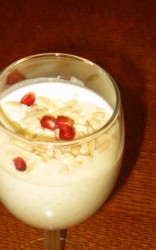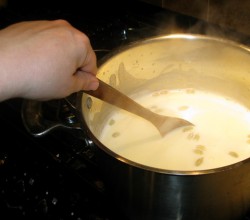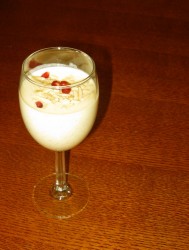A Sacred Sweet: Kheer
Kheer is the most common name for the many different puddings concocted from condensed milk, sugar and various other ingredients in India, but it is also known by many regional names such as phirni, payasa and kushmanda.
By any name, however, kheer is not only delicious, but is considered to be sacred by many Hindus, not only because it is made of milk–which is a staple food for Indian vegetarians, but because it is also used as an offering in temples, most particularly, in temples devoted to Krishna. One of Krishna’s epithets is Govinda, meaning “one who cares for the cows,” and he is often depicted as a cowherder, playing flute to soothe his charges, and to beguile the Gopis, his female devotees who also tended the cows of their village, Vrindavan.
Since cows are so central to the sacred stories of Krishna, it is unsurprising that offerings to Him made in temples and homes tend to be dairy-based foods, such as kheer. These offerings, after they have been set upon the altar, are later distributed to the worshipers at the temple, or among family members in the home, in essence, sharing the sacred food with each other and God.
I myself am not a practicing Hindu, but I have the utmost respect for the beliefs and practices of Hindus, and I have to admit that every time I taste well-made kheer I can completely understand why it is considered to be sacred.
What is kheer?
Simply said, it is an Indian sweet, rather like a pudding, that is made from milk that has been condensed by the process of reduction. Milk is brought to a frothing boil while being stirred constantly, then the heat is turned down so that the milk boils rapidly, but does not climb the edges of the pot. Stirring all the while, much of the water is evaporated away, until the milk is thickened enough to at least coat as spoon, though in some types of kheer, the milk is condensed further so that it truly is thick and textured much like what we Americans think of as a pudding. In general when making kheer, the volume of milk is reduced to 1/4 of the original measure.
Depending on the recipe, other ingredients are added–sugar is always added, though not as much as one might think, considering the finished flavor of the dessert. Uncooked basmati rice or seviya–a very fine vermicelli noodle–are often added and cooked with the milk. These starchy ingredients do not only add thickness to the finished sweet, they add flavor and texture. Dried fruits such as golden raisins or currants are often added, as well as lightly crushed or thoroughly ground nuts like almonds or pistachios. Cardamom pods are a common flavoring for kheer, as is rosewater and kewra essence.
(Right here, I want to say that kheer, while it is commonly described as being “like an Indian version of rice pudding”, it is nothing like the rice puddings I was served as a child growing up in West Virginia. Those puddings, flavored only with a weak drizzle of vanilla extract and thickened with cornstarch and full of lumpy, sticky rice and black raisins, haunt me to this day. I hated rice pudding as a child; it invariably made me gag for some reason, but I adore kheer. As a rice pudding hater, I am here to say to other rice-pudding haters out there in the world that kheer is not the same thing as your nemesis. It is really amazingly delicious. I promise.)
The kheer that you find in typical Indian restaurants in the United States varies widely in quality and flavor. Most often served cold, though sometimes served warm, I think the most common versions I have had are made with rice, maybe some raisins and sometimes some almonds, flavored only with cardamom pods. Very few restaurants seem to spend the time to reduce the milk very much; many a kheer I have eaten that is more like a milky rice soup than a pudding. This is sad, because while the reduction is primarily done for texture, it also is important for flavor–when milk is reduced properly, it has a very rich, somewhat naturally sweet flavor that is very pleasant and which is totally lacking in milk that is still in its near-native thin state.
The recipe I am presenting here is very similar to the one I watched the mother and aunt of my Pakistani personal chef clients make. I had been invited to an Eid feast, and came over early to help cook, and ended up tending two large pots of milk, once the ladies realized I could be trusted to stand over the steamy milk and stir continually, without my concentration wavering.
This meant that they could work on other dishes while I stirred two pots at once–a long wooden spoon in each hand. It was slow, hot work, but rewarding, because I learned how to make fantastic kheer that is better than what I have ever eaten in a restaurant! (I also got to listen to the ladies sing together, which was also great fun; I did not understand the words, but I could hum along.)
Making kheer, just as making any other Indian sweet, required dedication, patience and a good strong arm. You don’t quite stir the entire time the kheer cooks, but close to it. And you really should pay pretty good attention to the milk–while I can manage to pull up a stool and sit and stir while reading a book in the other hand, you must be careful and not lose track of what the milk is doing. One of the keys to good kheer is being a good observer of what is going on in the pot and when it is time to turn the heat down or add the next ingredient, and when to stir like the dickens and when to stir more languidly.
I want to give a few general tips and warnings before I give the recipe.
First, use the best quality, freshest milk you can afford for kheer. I use only Snowville Creamery milk at home anyway, but even if I didn’t, I’d get it just for this recipe just on principle. When milk is the main ingredient, and is the main flavoring agent, you want it to be really good.
Also, don’t bother using skim milk to make this. I’d hesitate to even bother with two-percent milk. Just go out and buy whole milk to make kheer, and don’t worry about the fat. The end result will be worth it, and frankly, you know that it isn’t going to be a health food in the first place–I mean, it is a dessert, after all–so don’t fret over the fat.
Raw (turbinado) sugar is very good in this recipe, but if you don’t have it around, white sugar is fine. Brown sugar and sugars like jaggery are not good choices because they can sometimes make the milk curdle when they are added. Not only that, but the darker sugars darken the color of the dessert and it should be a pale cream color when it is done.
Also, count the cardamom pods as they go into the pot and remember how many you put in. While it is not necessary to remove them before serving the kheer, I like to take them out, just so my guests don’t have to worry about biting into them. And if you know how many went in the pot, you know how many need to come out, and you won’t spend twenty minutes digging around in the finished kheer with chopsticks, trying to dig out a nonexistent last cardamom pod. (Do you get the idea that I have made this mistake in the past?)
Finally, you need to have a really large pot to make kheer–one that can hold three times as much milk as you start out with. So, drag out your stock pot or the pot you cook pasta in, but only if they have very heavy bottoms on them. Why does the pot need to be big? Well, it needs to be tall, because when you bring your milk to a frothy boil, the bubbles will climb right up the sides of your pot and try to overflow onto the stove and make a big, nasty, stinky mess all over the burners and everything. If your pot is tall, you have plenty of time to see the crisis coming on, and thus, you can turn the heat down fast. This makes the foam instantly collapse upon itself and slide back down into the bottom of the pot where it belongs. Then, you can adjust the temperature so that the milk is boiling rapidly, but not frothing.
Why does the pot need to have a heavy bottom? Because if you don’t have a good, heavy bottom on your pot, you are going to end up scorching your milk, which will not only stick to the bottom of your pot and be the devil itself to clean, it will ruin the flavor of the entire batch of kheer. And who wants to stand over a huge pot of boiling milk, stirring the whole time , only to have it burned not because you were remiss in your stirring duties, but because your pot is too thin and burned the milk up anyway.
This version of kheer has rice, cardamom, rosewater, golden raisins and almonds in it in addition to milk and raw sugar. In the spring or summer, I would garnish it with fresh or crystallized rose petals, but in the fall and winter, I like to use fresh pomegranate seeds. Their brilliant ruby-red color sparkles on the creamy-white kheer, making a lovely contrast. Lightly crushed pistachios would also make a lovely garnish for this dessert.
Most Indian restaurants and households serve kheer in small, shallow bowls, but I like how it looks presented in wine glasses.
It just looks rather elegant when presented in stemware. But, you can serve it however you like–just keep in mind that it is rich and so a little goes a very long way.
Kheer
Ingredients:
2 quarts whole milk
1 cup half and half or light cream
1/4 cup basmati rice
16-20 whole green cardamom pods
1/2 cup raw sugar
1/4 cup golden raisins
1/4-1 1/2 teaspoons rosewater (this depends on the strength of your rosewater–I use 1 teaspoon of Cortas in my kheer)
1/2 cup slivered raw almonds lightly toasted, then lightly crushed
fresh pomegranate seeds, rose petals or crushed pistachios as garnish
Method:
In a large, heavy-bottomed pot, stir the milk, half-and-half or cream, rice and cardamom pods over high heat. Stirring constantly, bring to a frothing boil, then immediately turn down the heat until the milk boils rapidly, but no longer foams or tries to climb up the sides of the pot and overflow onto the stove top. (This process takes between fifteen and twenty minutes of constant stirring and fairly steady attention. As I said, I pull up a stool in front of the stove and stir with one hand while reading a book in the other, but I always keep one eye on the pot to keep tabs on the progress of the milk mixture.)
Boil the milk, stirring fairly constantly (this means you can stop for a few seconds to turn a page, grab a drink of water or get your kid a cup of juice, but don’t go running off to the bathroom or anything), until it reduces to about half its original volume.
Stir in the sugar and raisins, and turn the heat down so that milk simmers instead of boils, and stir very attentively so as to avoid scorching the milk and ruining the flavor of the kheer. Keep simmering until the milk has reduced to one quarter of its original volume. At this point the rice will be cooked, the raisins will have softened and plumped and the kheer should be fragrant and well-flavored with the cardamom. It should also be easily thick enough to coat a spoon very well–when your draw your finger down the back of the coated spoon, it should leave a clean streak that does not fill itself back in from the rest of the kheer on the spoon.
Remove from the heat and stir to cool the kheer to near room temperature. Then, cover and chill for at least three hours before serving. The kheer will continue to thicken as it chills–when you serve it, this will be a thick, rich, creamy confection.
Just before serving, you can use a pair of chopsticks to pick out the cardamom pods (I leave them in while the kheer cools so that their flavor can continue to be absorbed into the kheer), or you can leave them in. Stir in the rosewater, starting with the smallest amount first, gradually adding more until you have the flavor you want. I don’t like my kheer to be overtly rose-flavored, but I do want a subtle floral fragrance to wend its way over the palate to dance with the sweet citrus scent of the cardamom.
Spoon into whatever serving vessels you desire, and sprinkle each serving with a generous portion of the almonds and whatever other garnishes you choose.
This recipe serves about eight people, more or less.
9 Comments
RSS feed for comments on this post.
Sorry, the comment form is closed at this time.
Powered by WordPress. Graphics by Zak Kramer.
Design update by Daniel Trout.
Entries and comments feeds.






Hello Barbara,
This post made me smile:) It is exactly how my north-indian ma makes kheer. Since you like kheer, here’s a small variation from my bengali mother called payesh in which you use jaggery or if available khejur gur. Khejur gur is jaggery made from the date plant. It is very difficult to describe its flavour, but it is fruity and smoky and dense and not-to-sweet all at the same time. The addition of jaggery or khejur gur gives the kheer a very different flavour. The entire cooking process is the same except that you do not add sugar to the milk at the beginning but towards the last twenty minutes of cooking by which time it has reduced substantially and so the gur will not curdle it. The resulting payesh is pale to deep brown, with a smoky, sweet, mysterious flavour.
Another variation on this is to use chenna instead of rice. Chenna is also called paneer. Basically you break milk with lemon juice or vinegar when it boils and drain the milk solids. It is like a fresh cheese. Chenna gur payesh (yes it is a bit of a dairy overload:) is very delicious.
Aarti
Comment by Aarti — November 2, 2009 #
As I was reading through, I wanted to make the same point that has now been brought up by Aarti.
While Jaggery is difficult to handle, using Jaggery from date plant is absolutely brilliant. I love that stuff.
Comment by Bheema V — November 2, 2009 #
Arti/Bheema: I’ve had that kind of payesh too, and it is great! Smoky and luscious. It’s a bit hard to find date jaggery in the US, but there’s one south indian store I know that has it, so may try that.
And I agree with Barbara – any kind of kheer is wonderful.
Comment by Diane — November 2, 2009 #
An enjoyable post, as yours usually are, but a caveat: there’s nothing ‘sacred’ about kheer.
Most Hindus, and not just Vaishnavas, followers of Vishnu, of whom Krishna is a much-loved avatar, or incarnation, would not eat beef, or kill a cow. Whether or not the cow is sacred to Hindus is not easy to answer. As a respected authority on Hinduism put it, â€â€¦â€™sacred’†means a lot more than not to be killed, and is, in any case, a Christian term that can be, at best, vaguely and inadequately applied in India.†That apart, if being made from milk is the reason for kheer being sacred, a large number of Indian foods would have to be considered sacred (whatever that means) – rasagolla, basundhi (both sweets made from milk), cottage cheese, yoghurt, buttermilk, various curries made from yoghurt, or containing cream….
A food doesn’t generically acquire special status just because it’s offered to a deity. What is offered is what tradition and folklore say the presiding deity likes to eat. The worshipper is trying to please him or her, after all. Thus, the offering in a temple to Bhagavati (one of the fierce aspects of the female divine) in Kerala that I once went to, is goat curry. Conversely, the offering to Krishna in many temples and on various occasions is food other than milk or milk products. Nor does a food become ‘sacred’ because it’s a staple; foodgrains are consumed far more abundantly than milk.
It’s interesting that one of the traditionally cooked dishes in many parts of India for Id ul Fitr, the Muslim feast that marks the end of the holy month of Ramadan is sevai kheer, also called sheer korma, a kheer made with vermicelli.
Payasam is a general term for a type of liquid or semi-liquid South Indian sweet many of which need not contain milk. I haven’t come across kushmanda. In which part of the subcontinent is kheer so called?
Comment by Gowri — November 2, 2009 #
An enjoyable post, as yours usually are, but a caveat: there’s nothing ‘sacred’ about kheer.
Most Hindus, and not just Vaishnavas, followers of Vishnu, of whom Krishna is a much-loved avatar, or incarnation, would not eat beef, or kill a cow. Whether or not the cow is sacred to Hindus is not easy to answer. As a respected authority on Hinduism put it, â€â€¦â€™sacred’†means a lot more than not to be killed, and is, in any case, a Christian term that can be, at best, vaguely and inadequately applied in India.†That apart, if being made from milk is the reason for kheer being sacred, a large number of Indian foods would have to be considered ‘sacred’ – rasagolla, basundhi (both sweets made from milk), cottage cheese, yoghurt, buttermilk, various curries made from yoghurt, or containing cream….
A food doesn’t generically acquire special status just because it’s offered to a deity. What is offered is what tradition and folklore say the presiding deity likes to eat. The worshipper is trying to please him or her, after all. Thus, the offering in a temple to Bhagavati (one of the fierce aspects of the female divine) in Kerala that I once went to, is goat curry. Conversely, the offering to Krishna in many temples and on various occasions is food other than milk or milk products. Nor does a food become ‘sacred’ because it’s a staple; foodgrains are consumed far more abundantly than milk.
It’s interesting that one of the traditionally cooked dishes in many parts of India for Id ul Fitr, the Muslim feast that marks the end of the holy month of Ramadan is sevai kheer, also called sheer korma, a kheer made with vermicelli.
Payasam is a general term for a type of liquid or semi-liquid South Indian sweet many of which need not contain milk. I haven’t come across kushmanda. In which part of the subcontinent is kheer so called?
Comment by Gowri — November 2, 2009 #
I’m sorry for repeating my rather long post. My computer decided to take matters into its own hands!
Comment by Gowri — November 2, 2009 #
Hi Barbara,
I’m a frequent reader of your lovely blog. Just wanted to let you know that your description of the significance and recipe for kheer are both fantastic.
I learned a lot from this post. I’m a South Indian living in updtate NY and and I love reading your blog whenever I’m hungry (which is pretty often)!
Thanks for all the wonderful posts.
jayasri
Comment by Jayasri — November 5, 2009 #
Hi Barbara,
I made this today for my 11-year-old daughter, who is in bed with strep throat. I substituted vanilla sugar and lemon zest for the cardomon and pomegranite seeds (which I didn’t have and can’t go out for!), and she loved it. Your recipe is perfect.
Next try, I’m using ginger while cooking, and topping with crushed candied ginger for a party.
Thanks!
Comment by Yogi — November 14, 2009 #
This sounds delicious! My local Indian restaurant serves something that sounds very similar to this, bar one thing: There’s has a definite coconut flavor.
Comment by Deborah — November 14, 2009 #